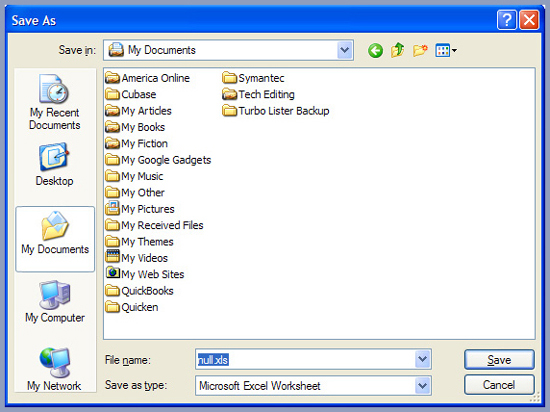Section 4. Creating, Opening, and Saving Google Spreadsheets
Google Spreadsheets makes it really easy to create new spreadsheets, save the ones you're working on, and reopen previously saved spreadsheets. You can also import your Excel spreadsheets and download your Google spreadsheets in XLS format to work on from within Excel.
Know, however, that Google Spreadsheets is still in beta testing, and that Google has set some limits as to how large a spreadsheet you can work with. At present, Google lets you create a maximum 100 spreadsheets. Each spreadsheet can contain up to 20 tabs (sheets), 50,000 cells, 256 columns, or 10,000 rows—whichever comes first. As to importing existing Excel spreadsheets, Google only lets you import files sized 400KB or less. (Which means you can't import really large Excel files.) Past that, you're free to use Google Spreadsheets however you see fit.
Creating a New Spreadsheet
Creating your first new Google spreadsheet is as easy as logging on to the main Google Spreadsheets page. When you access Google Spreadsheets, you're presented with a blank spreadsheet. That's your new spreadsheet to work with. (You can then save this spreadsheet, as we'll discuss in a moment.)
To create another new spreadsheet, you can either click the New link at the top of the page, or click the File button and select New. (Figure 10 shows the menu that appears when you click the File button.) Either action opens a new spreadsheet in a new browser window; the current spreadsheet you were working on remains open.
Figure 10 Use the File menu to create a new spreadsheet.

Opening an Existing Spreadsheet
As you continue to work with Google Spreadsheets, you'll want to return to spreadsheets you previously worked with. To open a spreadsheet you created during a previous session, either click the Open link or select File, Open. Either action opens the Open a Spreadsheet dialog box, shown in Figure 11. Click the spreadsheet you want to open from the list presented; that spreadsheet now opens in a new browser window.
Figure 11 Opening a previously saved spreadsheet.

note
A new browser window opens only if you have a saved spreadsheet currently open. If you have a new, blank spreadsheet open, the spreadsheet you select will open in the current browser window.
Importing a Spreadsheet from Excel
Google Spreadsheets lets you import XLS- and CSV-format spreadsheet files created with Microsoft Excel. You can then work with these Excel spreadsheets from within Google Spreadsheets.
note
XLS is the standard Excel worksheet format. A CSV (comma-separated values) file is a spreadsheet file in text format, with fields separated by commas.
To import an Excel file, follow these steps:
- Click the Open link or select File, Open.
- When the Open a Spreadsheet dialog box appears, click the Browse button.
- When the Choose File dialog box appears, navigate to and select the XLS or CSV file you want to import, then click the Open button.
- When the Open a Spreadsheet dialog box displays the message, "File imported successfully," click the Open Now link.
Google now displays the selected spreadsheet in a new browser window. You can now edit the spreadsheet as you like; Google automatically saves a copy of the file on its servers, for your future use.
Saving a Spreadsheet
When you are finished with a spreadsheet, you need to save the file. When you first save a file, you must do this manually—and give the file a name. After this first save, Google automatically resaves the file every time you make a change to the spreadsheet. In essence, this means that you only have to save the spreadsheet once; Google saves all further changes automatically.
Google's automatic file save feature is called, appropriately enough, Autosave.
To save a new spreadsheet, follow these steps:
- Click the Save button or select File, Save.
- When the dialog box shown in Figure 12 appears, enter a name for the spreadsheet.
Figure 12 Opening a previously saved spreadsheet.

- Click the OK button.
That's all there is to it. The spreadsheet is now saved on Google's servers, and you don't have to bother resaving it at any future point.
Just remember—the spreadsheet file you just saved isn't on your PC's hard disk. It's stored on Google's servers, which means you must be connected to the Internet to access it. That's the thing about Google Spreadsheets; Google handles all the file storage, and your computer is used merely to access the Google Spreadsheets site. There are no Google Spreadsheets files stored on your computer, period. (Although you can choose to manually download a copy of any Google Spreadsheets file to your PC, as explained in the "Exporting a Google Spreadsheet to Excel Format" section coming up in a few moments.)
Saving a Copy of a Spreadsheet
You can, however, save a copy of any spreadsheet under a different name. You might want to do this if you want to keep different versions of a spreadsheet, for whatever reason.
To save a copy of a spreadsheet under a different name, follow these steps:
- Select File, Save As.
- When the dialog box appears, enter a new name for the spreadsheet.
- Click the OK button.
This closes the current spreadsheet and displays the newly saved spreadsheet in the current browser window. Any further editing you do is to the new spreadsheet—until you reopen the original file, of course.
Renaming a Spreadsheet
Google also lets you change the name of any spreadsheet you've saved. To rename a spreadsheet, follow these steps:
- Select File, Rename.
- When prompted, enter a new name for the spreadsheet.
- Click the OK button.
The current spreadsheet is now assigned the new name.
Exporting a Google Spreadsheet to Excel Format
By default, all the spreadsheets you work with in Google Spreadsheets are stored on Google's servers. You can, however, download files from Google to your computer's hard drive to work with in Excel. In essence, you're exporting your Google spreadsheet to an XLS-format Excel file.
To export the current spreadsheet, follow these steps:
- Select File, Download as .XLS.
- When the File Download dialog box appears, as shown in Figure 13, click the Save button.
Figure 13 Downloading a Google Spreadsheets file.

- When the Save As dialog box appears, as shown in Figure 14, select a location for the downloaded file, rename it if you like, and then click the Save button.
Figure 14 Saving a spreadsheet file in XLS format.

The Google Spreadsheets file is saved in XLS format on your hard disk. You can now open that file with Excel, and work on it as you would with any Excel spreadsheet. Know, however, that whatever changes you make to the file from within Excel affect only the downloaded file, not the copy of the spreadsheet that still resides on the Google Spreadsheets site. If you later want to reimport the Excel file to Google Spreadsheets, select File, Upload New Version to upload the changed spreadsheet from your PC to Google's servers.
note
You can also export a Google spreadsheet as a CSV-format file by selecting File, Download as .CSV. You can then import the CSV-format file into Excel or any other spreadsheet program. (Excel will not directly open CSV-format files, however; you'll have to use the import function from within Excel.)
Deleting a Spreadsheet
Spreadsheets you create with Google Spreadsheets are saved on Google's servers indefinitely—unless you choose to manually delete a file. To delete a file, follow these steps:
caution
Be certain you want to delete a file before you attempt this operation. The delete action cannot be undone.
- Open the spreadsheet you want to delete.
- Select File, Delete.
- When asked if you really want to delete the file, as shown in Figure 15, click OK.
Figure 15 Google prompts you before you delete a spreadsheet.

That's it. The selected file is now deleted from Google's servers.
